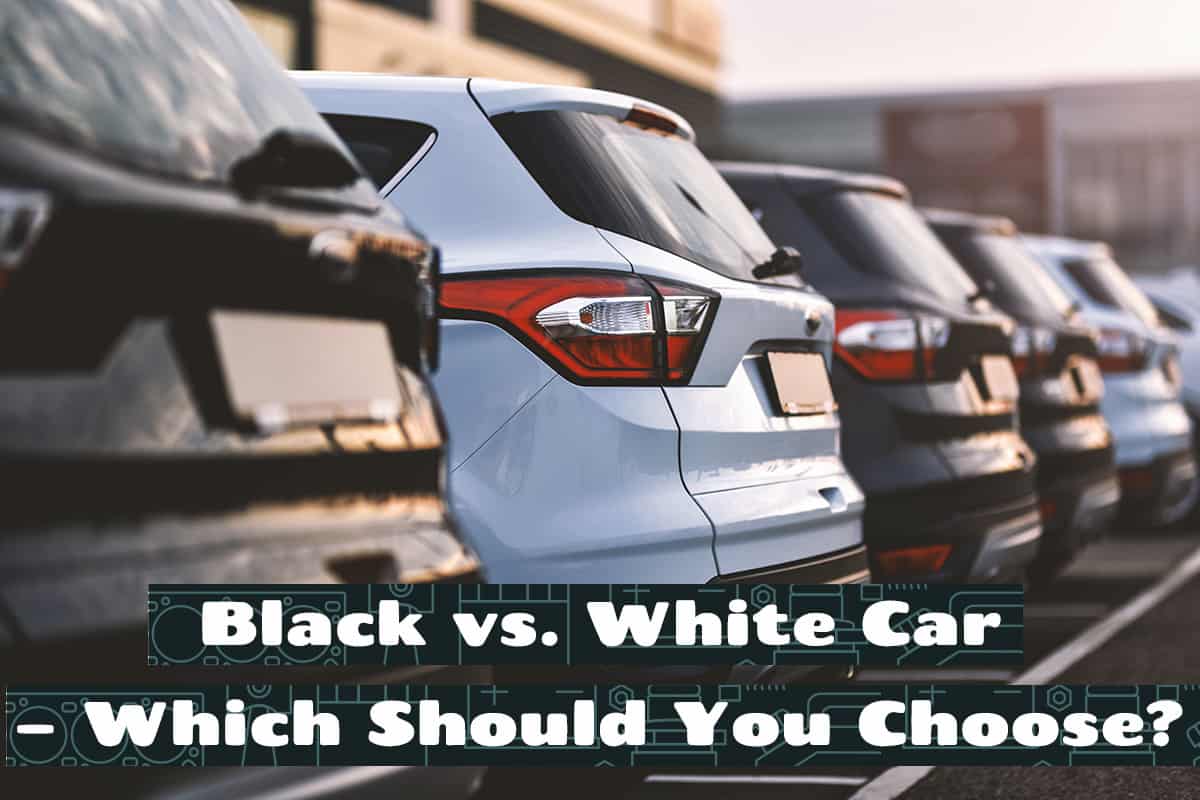The color of your car can have implications on various aspects beyond just aesthetics. Black and white are two common choices, but they present unique considerations that every car buyer should be aware of.
Depending on factors like your personal preferences, maintenance routine, and the climate you live in, either black or white could be ideal. It matters because the choice of car color can affect its visibility, heat absorption, perceived cleanliness, and overall value.
This guide will discuss these considerations, exploring the pros and cons of choosing a black or white car, from practicality to psychology, and giving you a comprehensive view to make a choice, whatever that is.
The Psychological Impact of Car Colors
The color of your car can send a powerful message about your personality and style. Understanding this can help you choose a color that aligns with your self-expression.
Black cars are often associated with sophistication, luxury, power, and elegance. They are a popular choice among individuals who prefer a classic, timeless look. Black cars are dominant on the road, projecting an image of authority and control. If you’re looking to present a powerful persona, a black car could be your perfect match.
On the other hand, white cars project an image of purity, cleanliness, and simplicity. They’re considered modern, efficient, and are typically associated with practical, detail-oriented individuals. Choosing a white car suggests you value precision and order, and appreciate a clean, minimalist aesthetic.
The Impact of Color on Car Maintenance
When it comes to showing dirt, dust, and scratches, there is a noticeable difference between black and white cars.
Black cars tend to show dirt, fingerprints, and minor scratches more readily than lighter colors. That’s because dirt and scratches often contrast sharply with the dark surface, making them stand out. So, for a black car to always look its best, you might need to wash and wax it more frequently. It’s also recommended to use a car-specific shampoo, which is designed to protect the paint while removing dirt. If you don’t mind the extra maintenance and take pride in a spotlessly clean vehicle, a black car could be the right choice.
In contrast, white cars do a better job of hiding dust and light scratches. They can go longer between washes while still looking relatively clean. That’s because the light color and reflective nature of white paint can help disguise light dust and minor blemishes. So, if you live in a dusty area or simply prefer less frequent car cleaning, a white car might be your best bet. However, keep in mind that harsh stains like bird droppings or bug splatter can be more noticeable on a white car and should be cleaned off promptly to avoid permanent marks.
Safety Considerations

When deciding between a black or white car, safety should also play a significant role in your decision. Studies have suggested that the color of your car may impact its visibility on the road and, therefore its safety. In this section, we delve into safety aspects related to the color of your car.
Visibility on the Road
Black cars are known to be less visible in low-light conditions such as dawn, dusk, and nighttime. The dark color can blend into the scenery, especially on roads without street lights. Additionally, during heavy rain, fog, or snow, a black car might be harder for other drivers to see.
Conversely, white cars are generally more visible under most conditions. Their bright color stands out against the road, other vehicles, and the surrounding environment, making them easier to see. White cars are particularly visible in darker conditions or adverse weather, providing a safety advantage in these situations.
Impact on Accident Rates
Statistically, black cars have been found to be involved in accidents more frequently than other colors, particularly during dawn and dusk when their visibility is reduced. However, it’s important to note that safe driving habits can significantly reduce the risk, regardless of your car’s color.
On the other hand, white cars tend to be involved in fewer accidents. The increased visibility of white cars can make them safer to drive, as they are easier for other road users to see.
How Color Affects Heat Absorption
In the world of automotive aesthetics, the choice between a black or white car often boils down to personal preference. However, there’s more to car color than meets the eye. In particular, the color of your car can have a significant impact on how much heat it absorbs, affecting interior temperatures, comfort, and fuel efficiency. Let’s explore this further.
Science Behind Heat Absorption in Different Colors
Black cars absorb more light because they absorb all wavelengths of light and convert them into heat. As a result, on a sunny day, a black car will become warmer than a white car. The absorption of light and subsequent conversion to heat is due to black objects not reflecting light back into the environment.
In contrast, white cars reflect most of the light that hits them because white is the presence of all colors, and each color within the light spectrum is reflected back. This is why you’ll find that white cars are cooler to the touch than black cars when both are parked under the sun.
Interior Temperatures
If you’ve ever entered a black car that’s been sitting in the sun, you’ve probably felt the intense heat right away. The seats, steering wheel, and other interior parts can become scorching hot. This is because the black paint absorbs a large amount of solar radiation, which then heats the car’s body and subsequently warms the interior.
White cars reflect most of the sun’s rays, meaning the car’s body and interior stay cooler. The interior of a white car can be several degrees cooler than that of a black car parked in the same location and under the same conditions.
The Effect of Car Color on Resale Value

The color of your car can influence how quickly it sells and how much money you can get for it in the used car market. In this section, we’ll examine how and why the color of your car might affect its resale value.
Market Demand and Popularity of Car Colors
Black cars are often seen as luxurious and stylish. They’re popular choices for luxury and high-performance vehicles, and this demand can translate into higher resale values for black cars. However, their appeal might be somewhat limited by their perceived high-maintenance needs.
White cars, on the other hand, are popular for their perceived ease of maintenance, and their bright, clean appearance appeals to many buyers. They are often the top choice for a variety of vehicle types, from family sedans to work trucks, which can enhance their resale value.
Condition and Appearance
Black cars can show signs of fading and aging quicker than lighter colors. Exposure to the sun can lead to noticeable fading, turning a once deep, glossy black into a duller, greyish color.
White cars are more resistant to visible fading, maintaining their appearance for longer. However, they might show rust or other forms of wear and tear more readily.
Environmental Considerations
The choice between a black or white car can have a small but noticeable impact on energy usage and emissions. Here, we’ll learn about the environmental considerations of choosing a car color.
Impact on Energy Usage
In a black car, the higher heat absorption can lead to hotter interior temperatures, particularly on sunny days. This, in turn, may lead to more frequent use of air conditioning to cool down the car’s interior, which can increase fuel consumption.
A white car, on the other hand, absorbs less heat, leading to cooler interior temperatures. This can mean less reliance on air conditioning, resulting in lower fuel consumption and potentially reduced CO2 emissions.
Manufacturing Process and Emissions
Traditionally, car manufacturers have used solvent-borne paints. The production and application of these paints can release volatile organic compounds (VOCs) into the atmosphere. VOCs contribute to air pollution and can have adverse health effects.
Nowadays, many car manufacturers have shifted to water-borne paints, which have lower VOC emissions. However, darker paints, including black, often require more layers or thicker coats to achieve a high-quality finish. Not to mention the complexity of getting the color looking just right.
In comparison, white paint typically requires fewer coats, leading to less paint used and potentially lower emissions during the manufacturing process.
Lifespan and End-of-life Disposal
Black cars can show signs of aging quicker due to color fading. If the car requires a repaint sooner, this could mean additional environmental impact from the paint production and application process.
White cars, while more resistant to visible fading, can show rust more readily. If this leads to a need for more frequent repairs or even a shorter overall lifespan of the car, this could have environmental implications in terms of resource usage and waste.
Black vs. White Car: Table Summary
| Aspect | Black Cars | White Cars |
| Aesthetics | Perceived as luxurious, classic and elegant | Seen as simple, modern, and clean |
| Maintenance | Show dirt and scratches easily, may require more upkeep | Hide scratches better, may show stains and dirt more readily |
| Safety | May be less visible at night | Higher visibility at all times |
| Heat Absorption | Absorb more heat, may lead to hotter interiors | Absorb less heat, generally cooler interiors |
| Resale Value | Might be favored for luxury vehicles, show age faster | Generally high demand, may maintain appearance longer |
| Environmental Impact | Could increase air conditioning use, more paint in production | Potentially reduce air conditioning use, less paint in production |
| Lifespan and Disposal | May require repainting sooner, potentially more waste | More resistant to fading, but potential for visible rust |







